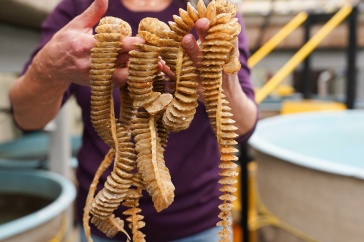Top row, LtoR/TtoB: Marjorie Mednikova installs a low marsh study plot in in the Great Bay National Estuarine Research Reserve near Jackson Estuarine Laboratory; Ribbed mussels (Geukensia demissa) are added to a study plot. Bottom row, LtoR/TtoB: Reece Ciampitti (left), a marine science student from Boston University, and Giovanni Quiñones, a visiting student from the University of Puerto Rico, install a study plot; From left, Marjorie Mednikova, Gregg Moore and Reece Ciampitti stand in front of a low marsh study plot.
Key Terms
Marsh resilience: Expand for definition
A measure of how vulnerable marshes are to changing climate and environmental conditions.
Ribbed mussel: Expand for definition
The ribbed mussel, Geukensia demissa, is a marine mollusk native to the North American Atlantic coast. Ribbed mussels natively live in low salt marshes buried in the mud. They serve as water filters, removing excess nutrients like nitrogen, and help stabilize marsh sediment and reduce erosion by connecting to plant roots and stems via tendon-like filaments called byssus threads.
Sediment thin-layer placement (TLP): Expand for definition
A strategy for restoring or maintaining tidal marsh function and coastal resilience that involves adding sediment and raising the elevation of the marsh surface to keep pace with sea level rise.
Salt marsh resilience and climate adaptation at UNH
The UNH Coastal Restoration and Resiliency Lab, led by Gregg Moore, associate professor of biological sciences, engages in basic and applied salt marsh studies across New England, with a particular emphasis on restoration, resilience and climate adaptation. The Lab’s ongoing projects, including in New Hampshire’s Great Bay Estuary and New England’s Great Marsh, involve monitoring marsh vegetation, hydrology and other factors to assess salt marsh ecosystem services. Moore and his team also work with local, state and federal partners to explore restoration strategies, such as channeling and ditch remediation, to address the effects of excessive historic ditching, marsh subsidence and sea level rise.
Around the globe, salt marshes—key habitats for a variety of plants and animals and important buffers to flooding caused by storm surges—are at risk of going extinct due to sea level rise and temperature increases. A recent NASA study estimates that 561 square miles of these coastal marshes have already disappeared in the last 20 years — the equivalent of two football fields every hour. In New England, it’s estimated that more than a third of salt marshes have disappeared since the 1700s.
Now, UNH scientists are leading research that for the first time combines the technique of adding new sediment from another area to increase the elevation of marsh, called sediment thin-layer placement (TLP), with another increasingly popular method of coastal marsh restoration and preservation: Adding the Atlantic ribbed mussel to the mix.
Stabilizing Marsh Restoration Sites With Mussels
Ribbed mussels help stabilize marshes by anchoring in the sediment and connecting to plants and other items using their byssal threads, or filaments, says Marjorie Mednikova ’26G, a marine biology doctoral student at the UNH College of Life Sciences and Agriculture. The mollusks also help with native vegetation growth by enhancing the nitrogen available within the sediment.
Mednikova is spending her summer setting up and monitoring a series of low marsh and pool habitat TLP plots located in the Great Bay National Estuarine Research Reserve near the Jackson Estuarine Laboratory (JEL). Working in the UNH Coastal Restoration and Resiliency Lab, led by Gregg Moore, associate professor of biological sciences, Mednikova and her team will measure the response of the marsh habitat to the TLP treatment and to the sediment strengthening provided by ribbed mussels.
“It’s research like this that makes it an exciting time for salt marsh restoration in New Hampshire.” ~ Gregg Moore, associate professor of biological sciences
“We’ll add 10-15 mussels to each sediment and mussel treatment within the next month,” says Mednikova, “and we expect that pairing the sediment treatment with the mussels will positively impact plant biomass while reducing erosion.”
From the data gathered from this pilot project, land managers will have an additional treatment option that they can explore and build into their marshland restoration strategies.
“Building off our successful pilot studies in partnership with the Great Bay National Estuarine Research Reserve, Marjorie’s experimental addition of local ribbed mussels to TLP plots may further kickstart functional recovery of damaged marsh,” says Moore. “If all goes as planned, her innovative addition will further demonstrate the benefit of designing with nature to promote living shoreline concepts in our Estuary.”
“It’s research like this that makes it an exciting time for salt marsh restoration in New Hampshire,” he added.
Funding for this research comes from the National Fish and Wildlife Foundation. Additional funding comes from the UNH Graduate School’s Summer Teaching Assistant Fellowship (STAF), the UNH School of Marine Science and Ocean Engineering (SMSOE) William R. Spaulding Marine Program Endowment and SMSOE’s Marine Biology program and graduate student fund.
-
Written By:
Nicholas Gosling '06 | COLSA/NH Agricultural Experiment Station | nicholas.gosling@unh.edu





















































